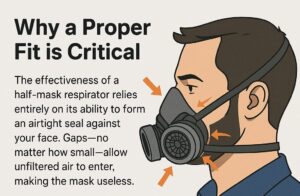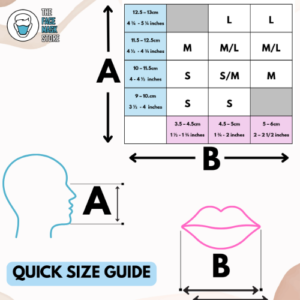Fit to Protect: Your No-Fuss Guide to Measuring for a Reusable Half Mask
Posted on 17th Apr 2025
Half-mask respirators are essential pieces of personal protective equipment (PPE) utilised across various settings, from industrial workplaces to personal DIY projects. They protect your lungs from harmful airborne contaminants such as dust, fumes, vapours, and biological particles. However, the effectiveness of a respirator is entirely dependent on its fit. An incorrectly sized mask can create gaps around the seal, allowing contaminants to leak in and compromise your safety. This guide will walk you through the process of measuring for a half-mask respirator to ensure a secure, comfortable, and protective fit.

As outlined by the Health and Safety Executive (HSE), UK workplace regulations such as COSHH (Control of Substances Hazardous to Health) require proper fit-testing for tight-fitting facepieces to ensure effective protection.
Key Points for a Good Fit
-
Measure before you buy:
Size is usually determined as Small, Medium, or Large. -
Face shape matters:
Width and length both affect mask fit and sealing quality. -
Fit-testing is a must:
You can’t rely on measurements alone. A fit test confirms the mask seals properly to your unique facial contours.
How to Measure Your Face for a Reusable Half-Mask

To determine your starting size, we recommend following a face-width method used by suppliers such as The Face Mask Store, along with an optional face-length check.
Face Width Method
You’ll need: a soft measuring tape or a ruler.
Steps:
-
Relax your face and close your mouth.
-
Place the ‘0’ mark at the centre of your lips.
-
Measure in a straight line past the outer edge of your mouth—around 2.5 cm (1 inch) beyond the corner.
-
Multiply this measurement by two to get your total face width.
Now compare that number with the chart below:
| Size | Face Width (Total) |
|---|---|
| Small | 10.2 cm (4 inches) |
| Medium | 11.4 cm (4.5 inches) |
| Large | 12.7 cm (5 inches) |
Choose the size closest to your measurement.
Face Length Method (Optional)
This secondary method is helpful if you have a longer or shorter face.
Measure from the bridge of your nose (between your eyes) to the bottom of your chin:
| Size | Face Length |
|---|---|
| Small | 110 mm ± 5 mm (10–11.5 cm) |
| Medium | 120 mm ± 5 mm (11.5–12.5 cm) |
| Large | 130 mm ± 5 mm (12.5–13.5 cm) |
These two measurements together give you a strong starting point for selecting the right mask size.
Other Factors That Affect Fit
Brand & Design Differences
Not all mask sizes are equal across manufacturers. For example, 3M, Moldex, GVS, and CleanSpace respirators may differ slightly in fit and materials. Always consult the manufacturer’s guide when available.
Facial Hair & Facial Features
Facial hair—beards, stubble, or sideburns—will break the seal. UK regulations usually require users to be clean-shaven in areas where the mask touches the skin. Face shape, scarring, glasses, recent dental work, or weight changes can also affect the fit.
Mask Positioning & Strap Adjustment
-
The nosepiece should sit comfortably on the bridge of your nose.
-
The mask should fit securely under your chin.
-
Adjust harness straps evenly – avoid over-tightening, which may distort the seal.
Fit-Testing
Measuring helps narrow down your size, but it’s not a guarantee of safety. Fit-testing is the only way to verify that your chosen mask properly seals to your face.
Under UK law (HSE/COSHH), fit-testing is mandatory for workplace users of tight-fitting respirators. This ensures the mask forms an effective barrier against harmful particles.
Two Types of Fit Tests
-
Qualitative Fit Test (QLFT)
A pass/fail test using a test agent like saccharin or Bitrex inside a hood. If the wearer can taste or smell the agent, the mask has failed. -
Quantitative Fit Test (QNFT)
A machine compares the number of particles inside and outside the mask to produce a ‘fit factor’. A half-mask requires a fit factor of at least 100 to pass.
You can read more about what to expect from a fit-test via University College London’s guide.
Daily Checks You Should Always Do
Even outside of formal fit-testing, it’s important to do a quick seal check every time you wear the mask:
-
Negative pressure test: Cover the filter inlets and inhale gently. The mask should pull inward with no leaks.
-
Positive pressure test: Cover the exhalation valve and exhale gently. The mask should bulge slightly with no air escaping.
Final Thoughts
Selecting the correct size and model of half-mask respirator is the first step toward respiratory safety. Accurate measurement helps, but only a proper fit-test can confirm protection. If you’re unsure, consult with a qualified fit-tester or check out our mask sizing guide to get started.